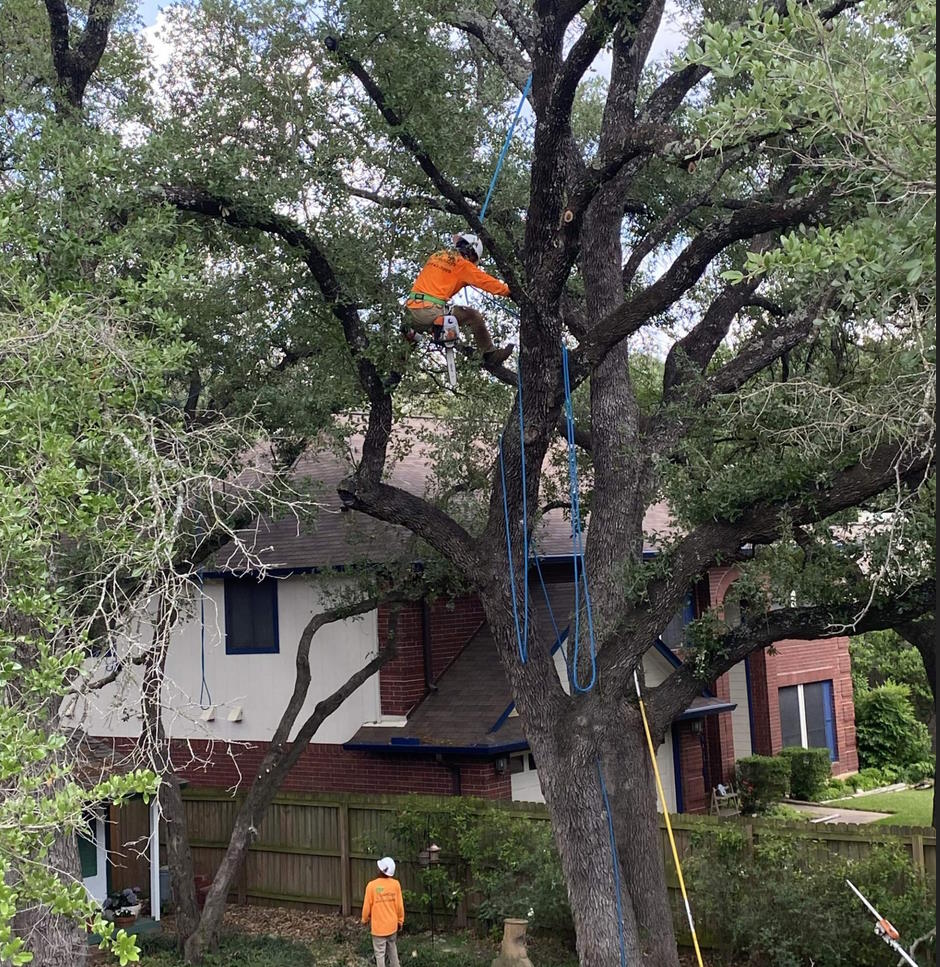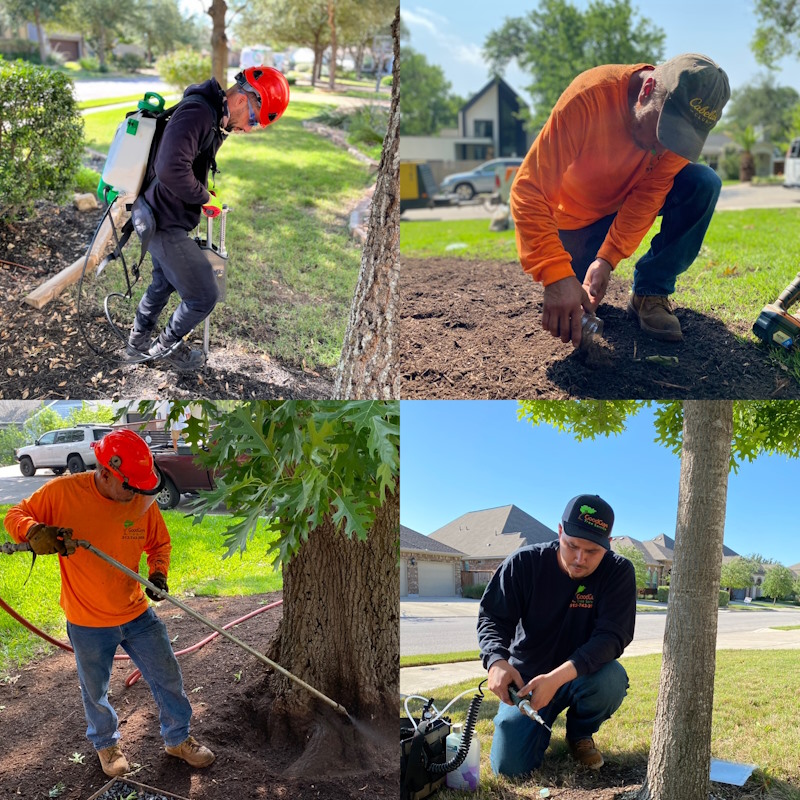Oak Wilt: a deadly fungal pathogen for some oak trees and often a confusing and heated topic of discussion for homeowners and tree lovers. It can lead to confusing and heated discussions because a lot of the information that circulates out there is based on hearsay or an incomplete and inaccurate understanding of the issue, as opposed to science and facts. Nevertheless, oak wilt is certainly a real problem and having good information about the issue will lead to better and more well-informed decision making around the health of your trees. In this blog post, I am only going to touch on the facts that have been proven and taught to me by members of the ISA who are Board Certified Master Arborists.
What is Oak Wilt?
Oak Wilt is a fungal disease that affects the xylem tissue of the red oak group (red, black, and pin oaks) and live oaks. The Xylem is the tissue that water travels through for the process of transpiration, which moves water from the roots through the trunk and branches out to the foliage where it is used for photosynthesis and released by the foliage through stomata cells to create a vapor to cool the foliage. When Oak Wilt spreads through the Xylem it clogs that layer and prevents water from getting to the foliage. This will cause the tree to go into decline and 95% of infected trees will eventually die. Sometimes there is a small portion of the Xylem that is not infected, allowing the tree to still put on a small amount of foliage. This could go on for years or months, but the tree will never fully recover and all the areas of the tree that are dead will begin to rot.
How is Oak Wilt Spread?
Oak Wilt is spread through root grafts (interconnected root systems) and through fungal spores from fungal mats on Red Oaks. Red Oaks are the only tree that will actually form a fungal pad and they only form fungal pads on 1 out 20 infected trees. The fungal pad forms under the bark and can attract the Nitidula beetle which can then carry spores from the fungal pad that it eats on to healthy trees and possibly transmit Oak Wilt to those trees. Because the fungal pad only forms on Red Oaks, Red Oaks with Oak Wilt should be destroyed immediately and never relocated for firewood. The fastest way to destroy a tree with Oak Wilt is to chip it on site. This dries it out and destroys the fungus. Oak Wilt is the same fungus throughout the US but there are different variables that affect the spread in different parts of the US.
I have been working with trees in Central Texas for the last dozen years. In 2011 we had the worst single year drought on record in the state of Texas. This drought greatly affected our Red Oaks or our Spanish Oaks in Central Texas. Many of our Spanish Oaks went into severe drought stress over the next few years and a good many of them ended up dying from Hypoxylon cankers. It is estimated that the 2011 drought killed over half a billion trees in the state of Texas. When it comes to trees there is what is called a death spiral, where several negative factors affect a tree’s health before something else comes in and kills it. With our Spanish Oaks in Central Texas it was the 2011 drought that weakened them and Hypoxylon cankers that killed them off. It was definitely a terrible thing to lose the majority of our Spanish Oaks over the last 12 years but we also lost the majority of the one type of tree that makes the Oak Wilt fungal pad.
Live Oaks usually catch Oak Wilt through root grafts, when trees’ root systems interconnect and fuse together underground. It is estimated that this is how 95% of Live Oaks get Oak Wilt. Oak Wilt travels at a rate of 75′ a year through root grafts. You can track it on Oak Wilt maps online that have been created to monitor the spread. It is very noticeable in rural areas where there is not a lot of infrastructure. In urban environments we have a lot of infrastructure like streets, water lines, sewage lines, gas lines, and other buried utilities that have the benefit of breaking up these root systems and slowing down the spread of Oak Wilt. Most of a tree’s root system is located in the top couple of feet of dirt. This is important because most utility codes require utilities to be installed at a minimum of 18″ below grade. This breaks up a lot of potentially harmful root grafts but it also cuts some very important roots on older established trees. Trees don’t like having their roots cut and it can be very harmful if not deadly to them.
Oak Wilt Prevention and Treatment
Prevention is much better than treatment. Once an Oak has Oak Wilt there is no cure, no matter what anyone tells you. You may be able to slow the decline down for a bit by treating it with the fungicide Propiconazole but eventually the tree will succumb to the fungus. Propiconazole is a very strong fungicide and is used more as a preventative than a treatment. In an urban setting you can follow the path of Oak Wilt spread through neighborhoods. Given the rate of spread through root grafts of 75’ per year, it’s recommended that you inject your Oaks with Propiconazole when you know Oak Wilt is within about 100′ of the Oaks that you want to protect. 18 months after you inject your Oaks, inject them a second time with the fungicide. Hopefully, within this time the Oak Wilt has passed you by and your Oak trees are safe for the time being.
The only thing better than Propiconazole injections for prevention is trenching. Unfortunately, this option is not available to most of us in urban settings because of buried utilities and not enough room to do it properly. Keep in mind that nothing is 100% guaranteed. Also, the only way that a person can be 100% sure that they have Oak Wilt is to send in a sample and have a lab verify the fungus under a microscope. Don’t believe everything you hear and read. Believe the science, not the rumors. Having the facts and the science around oak wilt will help property owners to be able to properly care for their oak trees and take the right steps to protect them.
Additional helpful information can be found on the city of Austin’s website, under Oak Wilt 101 (https://www.austintexas.gov/blog/oak-wilt-101) and through Texas A&M Forest Services site dedicated to oak wilt education and tracking (www.texasoakwilt.org).







